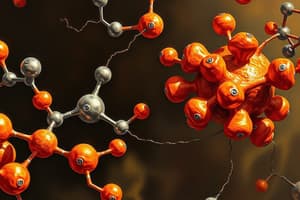Podcast
Questions and Answers
What is a small biological molecule that serves as a solvent for many reactions inside cells?
What is a small biological molecule that serves as a solvent for many reactions inside cells?
- Water (correct)
- Glucose
- Vitamins
- Minerals
Which atom serves as the central core of a glucose molecule?
Which atom serves as the central core of a glucose molecule?
- Carbon (correct)
- Hydrogen
- Oxygen
- Nitrogen
What category do carbohydrates fall under among the four main groups of large biological macromolecules?
What category do carbohydrates fall under among the four main groups of large biological macromolecules?
- Nucleic Acids
- Carbohydrates (correct)
- Lipids
- Proteins
Which type of bond holds together the subunits of large biological macromolecules?
Which type of bond holds together the subunits of large biological macromolecules?
What is the primary function of carbohydrates in cells?
What is the primary function of carbohydrates in cells?
Which macromolecule is essential for maintaining cellular structure and performing vital functions within the body?
Which macromolecule is essential for maintaining cellular structure and performing vital functions within the body?
What is the main structural component of plant cell walls?
What is the main structural component of plant cell walls?
Which of the following is not a common lipid?
Which of the following is not a common lipid?
What is the role of proteins in cellular processes?
What is the role of proteins in cellular processes?
Which of the following is not a level of protein structure?
Which of the following is not a level of protein structure?
What is the role of RNA in the cell?
What is the role of RNA in the cell?
Which of the following is not a type of organic macromolecule?
Which of the following is not a type of organic macromolecule?
Flashcards are hidden until you start studying
Study Notes
Biological molecules, also known as biomolecules, are fundamental units that build cells and drive various biological processes in living organisms. They are classified into small and large molecules, with the larger ones being called biological macromolecules. These macromolecules are essential for maintaining cellular structure, carrying genetic information, and performing vital functions within the body.
Small Biological Molecules
Small biological molecules include water, vitamins, minerals, and other important organic compounds. One of the most prevalent examples of small biological molecules is water (H2O), which serves as a solvent for many reactions inside cells. Water is essential for maintaining a healthy balance of fluids and electrolytes, regulating body temperature, and transporting nutrients and waste products.
Another example of a small biological molecule is glucose, a simple sugar used for energy production within cells. Glucose is composed of carbon, oxygen, and hydrogen atoms, with carbon serving as the central core of the molecule.
Large Biological Macromolecules
Large biological macromolecules are typically composed of multiple subunits called monomers, which are held together through covalent, hydrogen, or ionic bonds. These molecules can be categorized into four main groups: carbohydrates, lipids, proteins, and nucleic acids.
Carbohydrates
Carbohydrates are organic macromolecules that store energy and provide structural support to cells. Examples of carbohydrates include starch, cellulose, and chitin. Starch is a storage molecule found in plants and animals, while cellulose is the main structural component of plant cell walls. Chitin is a similar molecule found in the exoskeletons of arthropods and fungal cell walls.
Lipids
Lipids are another type of organic macromolecules that provide energy storage, insulation, and structural support. They are generally nonpolar and insoluble in water. Common lipids include triglycerides (fats stored in adipocytes) and phospholipids (components of cell membranes).
Proteins
Proteins are complex macromolecules composed of one or more chains of amino acids. They play a crucial role in various cellular processes, including growth, repair, and immune response. Some proteins act as enzymes, catalyzing biochemical reactions, while others function as receptors, hormones, and structural components of cells. Proteins have diverse structures, including primary, secondary, tertiary, and quaternary levels, allowing them to perform a wide range of functions. Examples of proteins include hemoglobin, myoglobin, and antibodies.
Nucleic Acids
Nucleic acids are essential biological macromolecules that store and transmit genetic information within cells. They are composed of nucleotides, which consist of a pentose sugar, a phosphate group, and a nitrogenous base. Deoxyribonucleic acid (DNA) is a double-stranded polymer of nucleotides that carries the genetic instructions for the development and function of an organism. Ribonucleic acid (RNA) is a single-stranded polymer of nucleotides involved in protein synthesis and gene expression regulation.
In summary, biological molecules are integral to the functioning of cells and living organisms. They are classified into small and large molecules, with large molecules further divided into carbohydrates, lipids, proteins, and nucleic acids. These macromolecules serve diverse functions, providing energy, structural support, and regulatory mechanisms necessitating their importance in sustaining life.
Studying That Suits You
Use AI to generate personalized quizzes and flashcards to suit your learning preferences.





